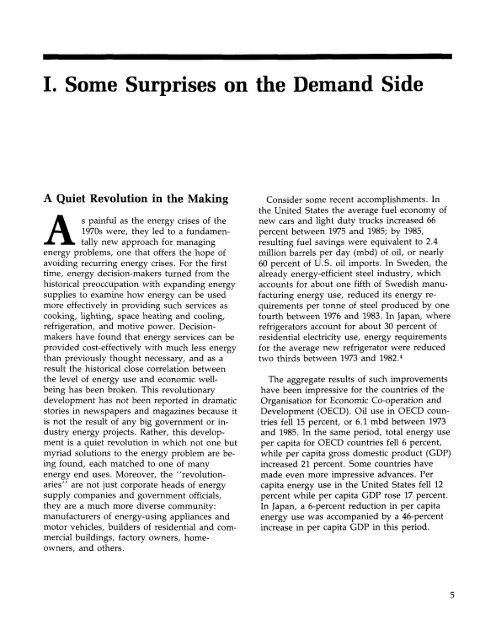ENERGY FOR A SUSTAINABLE WORLD - World Resources Institute
ENERGY FOR A SUSTAINABLE WORLD - World Resources Institute
ENERGY FOR A SUSTAINABLE WORLD - World Resources Institute
You also want an ePaper? Increase the reach of your titles
YUMPU automatically turns print PDFs into web optimized ePapers that Google loves.
I. Some Surprises on the Demand Side<br />
A Quiet Revolution in the Making<br />
A<br />
s<br />
painful as the energy crises of the<br />
1970s were, they led to a fundamentally<br />
new approach for managing<br />
energy problems, one that offers the hope of<br />
avoiding recurring energy crises. For the first<br />
time, energy decision-makers turned from the<br />
historical preoccupation with expanding energy<br />
supplies to examine how energy can be used<br />
more effectively in providing such services as<br />
cooking, lighting, space heating and cooling,<br />
refrigeration, and motive power. Decisionmakers<br />
have found that energy services can be<br />
provided cost-effectively with much less energy<br />
than previously thought necessary, and as a<br />
result the historical close correlation between<br />
the level of energy use and economic wellbeing<br />
has been broken. This revolutionary<br />
development has not been reported in dramatic<br />
stories in newspapers and magazines because it<br />
is not the result of any big government or industry<br />
energy projects. Rather, this development<br />
is a quiet revolution in which not one but<br />
myriad solutions to the energy problem are being<br />
found, each matched to one of many<br />
energy end uses. Moreover, the "revolutionaries"<br />
are not just corporate heads of energy<br />
supply companies and government officials,<br />
they are a much more diverse community:<br />
manufacturers of energy-using appliances and<br />
motor vehicles, builders of residential and commercial<br />
buildings, factory owners, homeowners,<br />
and others.<br />
Consider some recent accomplishments. In<br />
the United States the average fuel economy of<br />
new cars and light duty trucks increased 66<br />
percent between 1975 and 1985; by 1985,<br />
resulting fuel savings were equivalent to 2.4<br />
million barrels per day (mbd) of oil, or nearly<br />
60 percent of U.S. oil imports. In Sweden, the<br />
already energy-efficient steel industry, which<br />
accounts for about one fifth of Swedish manufacturing<br />
energy use, reduced its energy requirements<br />
per tonne of steel produced by one<br />
fourth between 1976 and 1983. In Japan, where<br />
refrigerators account for about 30 percent of<br />
residential electricity use, energy requirements<br />
for the average new refrigerator were reduced<br />
two thirds between 1973 and 1982. 4<br />
The aggregate results of such improvements<br />
have been impressive for the countries of the<br />
Organisation for Economic Co-operation and<br />
Development (OECD). Oil use in OECD countries<br />
fell 15 percent, or 6.1 mbd between 1973<br />
and 1985. In the same period, total energy use<br />
per capita for OECD countries fell 6 percent,<br />
while per capita gross domestic product (GDP)<br />
increased 21 percent. Some countries have<br />
made even more impressive advances. Per<br />
capita energy use in the United States fell 12<br />
percent while per capita GDP rose 17 percent.<br />
In Japan, a 6-percent reduction in per capita<br />
energy use was accompanied by a 46-percent<br />
increase in per capita GDP in this period.

















